Electrochemical Formation and Characterization of Functional Ag-Re Coatings
Abstract
:1. Introduction
2. Experimental Section
2.1. Bath Composition and Procedure
2.2. Electrochemical Measurements
2.3. Surface Morphology, Chemical Composition and Crystallographic Structure Characterization
2.4. Microhardness, Adhesion and Porosity Measurements
3. Results and Discussion
3.1. Voltammetric Studies
3.1.1. Results of Studies of Stationary Potential
3.1.2. Results of Studies of Potentiodynamic Polarization Curves
3.1.3. The Effect of Surfactants on the Electrode Process
3.2. Electrodeposition of Ag-Re Coatings
3.2.1. Dependency of Deposit Composition and Morphology on Current Density and Hydrodynamic Electrolysis Condition
3.2.2. Dependency of Deposit Composition and Morphology on Bath Temperature
3.2.3. Dependency of Deposit Composition and Morphology on Electrolyte Component Ratios
3.2.4. Dependency of Deposit Composition and Morphology on Surfactant Addition
3.2.5. X-Ray Phase Analysis
3.2.6. Characterizing Coating Microhardness, Adhesion, and Porosity
4. Conclusions
Author Contributions
Funding
Institutional Review Board Statement
Informed Consent Statement
Data Availability Statement
Acknowledgments
Conflicts of Interest
References
- Silver Based Materials. 2023. Available online: https://www.electrical-contacts-wiki.com/index.php?title=Silver_Based_Materials&mobileaction=toggle_view_desktop (accessed on 19 August 2024).
- Cameron, D.S. Chemistry, Electrochemistry, and Electrochemical Application|Silver. In Encyclopedia of Electrochemical Power Sources; Garche, J., Ed.; Elsevier: Amsterdam, The Netherlands, 2009; pp. 876–882. [Google Scholar] [CrossRef]
- Balakai, V.I.; Arzumanova, A.V.; Starunov, A.V.; Balakai, I.V. Properties of Electrolytic Silver-Based Alloy. Inorg. Mater. Appl. 2018, 9, 947–953. [Google Scholar] [CrossRef]
- Księżarek, S.; Woch, M.; Klir, T.; Kołacz, D.; Karpiński, M.; Rudnicki, K. Environmentally friendly silver-based contact materials. Ores Non-Ferr. Met. 2012, 57, 549–555. [Google Scholar]
- Kuzmar, I.; Lanin, V.; Pas, N.; Khmyl, A. Composite electroplated coatings based on silver for electronic products. Technol. Electron. Ind. 2006, 6, 58–60. [Google Scholar]
- Bogush, N.V.; Khmyl, A.A.; Kushner, L.K.; Dezhkunov, N.V. Composition, structure and functional properties of silver-tungsten composition electrochemistry coatings formed with the help of ultrasound. Dokl. BGUIR 2021, 19, 23–31. [Google Scholar] [CrossRef]
- Bogush, N.V.; Khmyl, A.A.; Kushner, L.K. Structure and physical-mechanical properties of silver-tungsten composite coatings obtained by electrochemical deposition. Dokl. BGUIR 2017, 107, 54–61. [Google Scholar]
- Kołacz, D.; Księżarek, S.; Woch, M.; Karwan-Baczewska, J.; Staszewski, M.; Rudnicki, K.; Borkowski, P.; Sienicki, A. Nanocrystalline Ag-Re Composite as a Potential Material for Electric Contacts Fabrication. Arch. Metall. Mater. 2016, 61, 1847–1852. [Google Scholar] [CrossRef]
- E.U. Turns. (General Dynamics, Ft. Worth, Texas) Industrial Development of the Silver-Rhenium Alloy Plating Process. In Proceedings of the 57th National Convention of the Arer. Electroplaters Soc, Montreal, QC, Canada, 21–25 June 1970. [Google Scholar]
- Jones, T. Rhenium plating. Met. Finish. 2003, 86–96, 101. [Google Scholar] [CrossRef]
- Jones, T. Electrodeposition of the Lesser-Known Precious Metals: Osmium, Iridium, Rhodium, Rhenium, Ruthenium, Revised Edition; Finishing Publications Ltd.: Warrington, UK, 2005; 214p. [Google Scholar]
- Sadana, Y.; Wang, Z. Electrodeposition of Alloys. XX: Electrodeposition of Gold Rhenium Alloys from Acidic Citrate Solutions and Their Xray Structure. Surf. Coat. Technol. 1989, 37, 419–434. [Google Scholar] [CrossRef]
- Nguyen, Y.N.; Yoon, J.; Shin, J.; Son, I. Electrodeposition of Pd-Ag alloy for electrical contacts. Surf. Eng. 2022, 38, 633–640. [Google Scholar] [CrossRef]
- Povetkin, V.V.; Skifsky, S.V.; Koreshkova, E.V. Electrolyte for deposition of copper-rhenium alloy. Patent: RU 2 234 560 C1, 27 June 2004. Available online: https://patenton.ru/patent/RU2234560C1 (accessed on 20 August 2004).
- Kołacz, D.; Księżarek, S.; Woch, M.; Karwan-Baczewska, J.; Staszewski, M.; Rudnicki, K.; Borkowski, P.; Sienicki, A. Nanocrystalline Ag-Re composite as a potential material for electric contacts fabrication. In Proceedings of the 27th International Conference on Electrical Contacts, Dresden, Germany, 22–26 June 2014; pp. 451–456. Available online: https://ieeexplore.ieee.org/document/6857211 (accessed on 17 July 2014).
- Księzarek, S.; Woch, M.; Kołacz, D.; Kamińska, M.; Borkowski, P.; Walczuk, E. Progress in fabrication technology of silver-based contact materials with particular account of the Ag-Re and AgSnO2Bi2O3 composites. In Proceedings of the 26th International Conference on Electrical Contacts and the 4th International Conference on Reliability of Electrical Products and Electrical Contacts, Beijing, China, 14–17 May 2012; pp. 186–193. Available online: https://core.ac.uk/download/pdf/53096993.pdf (accessed on 21 January 2016). [CrossRef]
- Hauner, F.; Jeannot, D.; Pinard, J. AgFe and AgFe2O3 Contact Materials for Voltage Switcher. In Proceedings of the 19th International Conference on Electric Contact Phenomena, Nurnberg, Germany, 14–17 September 1998; pp. 317–323. [Google Scholar]
- Kołacz, D.; Księżarek, S.; Borkowski, P.; Karwan-Baczewska, J.; Lis, M.; Kamińska, M.; Juszczyk, B.; Kulasa, J.; Kowalski, A.; Wierzbicki, Ł.; et al. The Influence of Mechanical Alloying and Plastic Consolidation on the Resistance to Arc Erosion of the Ag-Re Composite Contact Material. Materials 2021, 14, 3297. [Google Scholar] [CrossRef]
- Borkowski, P.; Walczuk, E.; Frydman, K.; Wojcik-Grzybek, D. Switching properties of contacts made of silver-tungsten and silver-tungsten-rhenium composite. In Proceedings of the 59th IEEE Holm Conference on Electrical Contacts, Newport, RI, USA, 22–25 September 2013; pp. 197–206. [Google Scholar] [CrossRef]
- Księżarek, S.; Kołacz, D.; Czepelak, M.; Śmieszek, Z.; Marszowski, K. Technological aspects of plastic working of the Ag-Re(5, 8 and 10) wt % composite contact material. Metall. Metall. Eng. News 2011, 8, 633–636. [Google Scholar]
- Farmakovsky, B.V.; Somkova, E.A.; Sergeeva, O.S.; Yurkov, M.A.; Tochenyuk, D.A.; Bystrov, R.Y.; Semenov, A.S.; Peskov, T.V.; Gerashchenkov, D.A. Silver-Based Alloy for Nanostructured Coatings. Patent RU 2350673, 27 March 2009. Available online: https://patenton.ru/patent/RU2350673C1.pdf (accessed on 27 March 2009).
- Bersirova, O.L.; Kochetova, S.A.; Bondar, O.O. Synthesis and characterization of electrolytic Ag-Re coatings. In Proceedings of the 2nd International Research and Practice Conference “Nanoobjects & Nanostructuring” (N&N-2022), Lviv, Ukraine, 23–25 September 2022; pp. 57–58. Available online: https://drive.google.com/file/d/1TROnAqz8nft88hJ9adnHajWc_JEpGWa9/view (accessed on 21 September 2022).
- Shibleva, T.G.; Povetkin, V.V.; Ivanova, T.E. Electrolyte for Deposition of Silver-Rhenium Alloy. Patent RU 2459017C1, 20 August 2012. Available online: https://patenton.ru/patent/RU2459017C1 (accessed on 20 August 2012).
- Ivanov, A.F.; Kruglikov, S.S.; Mikhailova, A.N.; Ivanova, G.D.; Goncharov, V.K. Electrolyte for Coating Silver-Rhenium Alloys. Copyright certificate RUS No. 627188. Application No. 2473785, 5 October 1978. Available online: https://patenton.ru/patent/SU627188A1 (accessed on 5 October 1978).
- Ivanov, A.F.; Ginzberg, S.A. Electrolyte for the Deposition of Silver-Based Alloys. Patent SU 528356A1, 15 September 1976. Available online: https://patenton.ru/patent/SU528356A1 (accessed on 15 September 1976).
- Khmyl, A.A.; Kushner, L.K.; Kuzmar, I. Peculiarities of the formation of functional coatings silver—Rhenium oxides. In Creation of New and Improvement of Existing Technologies and Equipment for Applying Galvanic and Their Replacement Coatings, Proceedings of the Materials of the 5th Republican Scientific and Technical Seminar, Minsk, Belarus, 22–23 December 2015; Zharsky, I.M., Dormeshkin, O.B., Chernik, A.A., Eds.; Belarusian State Technological University BSTU: Minsk, Belarus, 2015; pp. 4–7. [Google Scholar]
- Turns, E.W.; Head, J.W.; Hoffman, H.C.; Porter, A.C. Process for Lubricating a Bearing Surface. U.S. Patent 3,342,708, 19 September 1967.
- Cao, H.; Chai, D.; Wu, L.; Zheng, G. Communication—A Mechanistic Study on Electrodeposition of Rhenium from Acidic Solution of Ammonium Perrhenate. J. Electrochem. Soc. 2017, 164, D825. [Google Scholar] [CrossRef]
- Bersirova, O.; Byk, S.; Kublanovsky, V. Electrodeposition of silver. In Monograph; Medinform: Kyiv, Ukraine, 2013; 168p, Available online: http://www.ionc.kiev.ua/deposite/Ag_electrodeposition.pdf (accessed on 16 June 2017).
- Bersirova, O.; Kublanovsky, V.; Emelianov, V.; Anufriev, L. Electrodeposition of functional silver coatings from borate-phosphate-carbonate baths. Chemija 2003, 14, 16–21. [Google Scholar]
- Bersirova, O.; Kublanovsky, V.; Cesiulis, H. Electrochemical Formation of Functional Silver Coatings: Nanostructural Peculiarities. ECS Trans. 2013, 50, 155–163. [Google Scholar] [CrossRef]
- Hamdi, R.; Rached, A.; Massoudi, I.; Al-Zuraie, R.; Al-Hamadah, K.; Al-Otaibi, A.; Flemban, T.; Alonizan, N.; Ghrib, T. Electrodeposition Study of Silver: Nucleation Process and Theoretical Analysis. J. Electron. Metarial 2021, 50, 5507–5513. [Google Scholar] [CrossRef]
- Burkat, G.K.; Safronova, I.V. Electrodeposition of silver from dicyanoargenate electrolyte in the presence of nanocarbon additives. Mod. Probl. Sci. Educ. 2014, 2, 1–8. Available online: https://s.science-education.ru/pdf/2014/2/513.pdf (accessed on 8 April 2025).
- Bersirova, O.L.; Kublanovskii, V.S. Crystalline Roughness as a Morphological Characteristic of the Surface of Electroplated Silver Coatings. Russ. J. Appl. Chem. 2009, 82, 1944–1948. [Google Scholar] [CrossRef]
- Bersirova, O.; Kublanovsky, V.; Bersirov, S. Modeling the Composition of the Pre-Cathode Layer in Dicyanoargentate Buffer Electrolyte without Excess Ligand. In Proceedings of the 12th International Conference Nanomaterials: Application & Properties 2022 NAP-2022, Krakow, Poland, 11–16 September 2022. [Google Scholar] [CrossRef]
- Bersirova, O.; Kublanovsky, V. Electrochemical Behavior of Silver in Dicyanoargentate Electrolytes. In Proceedings of the 7th International Conference Nanomaterials: Application & Properties 2017 NAP-2017, Zatoka, Ukraine, 10–15 September 2017; Available online: https://ieeexplore.ieee.org/stamp/stamp.jsp?arnumber=8190157 (accessed on 14 December 2017).
- Jasni, A.B.; Yoshihara, S. Electrodeposition of Silver in Cyanide-Free Solution Containing Pyrimidine Derivative as a Complexing Agent. J. Electrochem. Soc. 2023, 170, 092504. [Google Scholar] [CrossRef]
- Bersirova, O.L.; Kublanovsky, V.S. Electrolytic Nickel-rhenium alloys: Synthesis, structure and corrosion properties. Mater. Sci. 2019, 54, 506–511. [Google Scholar] [CrossRef]
- Kuznetsov, V.V.; Gamburg, Y.; Zhulikov, V.V.; Krutskikh, V.M.; Filatova, E.A.; Trigub, A.L.; Belyakova, O.A. Electrodeposited NiMo, CoMo, ReNi, and electroless NiReP alloys as cathode materials for hydrogen evolution reaction. Electrochim. Acta. 2020, 354, 136610. [Google Scholar] [CrossRef]
- Cao, H.; Hu, L.; Zhang, H.; Hou, G.; Tang, Y.; Zheng, G. The significant effect of supporting electrolytes on the galvanic deposition of metallic rhenium. Int. J. Electrochem. Sci. 2020, 15, 6769–6777. [Google Scholar] [CrossRef]
- Zhulikov, V.V.; Gamburg, Y.D. Eelectrodeposition of rhenium and its alloys. Russ. J. Electrochem. 2016, 52, 847–857. [Google Scholar] [CrossRef]
- Naor, A.; Eliaz, N.; Gileadi, E. Electrodeposition of Alloys of Rhenium with Iron-Group Metals from Aqueous Solutions. J. Electrochem. Soc. 2010, 157, D422. [Google Scholar] [CrossRef]
- Rhenium. Term Paper. File Archive of Students Studfile. Available online: https://studfile.net/preview/2474240/page:3/ (accessed on 25 March 2015).
- DePew, J.R.; Larson, T.L. Electrodeposition of rhenium for wear resistance. A preliminary report. Plating 1970, 475–478. [Google Scholar]
- ISO 2409; Paints and varnishes—Cross-cut test. International Organization for Standardization: Geneva, Switzerland, 2020.
- Brantsevich, V.K. Influence of electrolyte composition on the structure and properties of composite electrochemical coatings based on silver. In Proceedings of the Materials of the 48th Scientific Conference of Graduate Students, Undergraduates and Students, Minsk, Belarus, 7–11 May 2012; pp. 120–121. [Google Scholar]
- Antropov, L.I. Theoretical Electrochemistry; Mir Publisher: Moscow, Russia, 1972. [Google Scholar]
- Grall, M. Electrochemical Study of Chemical Properties in Ethanolamine and Its Mixtures with Water; CEA Fontenay-aux-Roses: Paris, France, 1964; Available online: https://inis.iaea.org/search/search.aspx?orig_q=RN:36065597 (accessed on 12 January 2025).
- Cesiulis, H.; Bersirova, O.; Valiuniene, A.; Prosycevas, I.; Baltrunas, G. Structure and Morphology of Silver Electrodeposits. Mater. Sci. 2004, 10, 142–146. [Google Scholar]
- Majid, C.A.; Hussain, M.A. Structural transformations in polycrystalline rhenium trioxide. Phw. Chem. Solids 1995, 56, 255–259. [Google Scholar] [CrossRef]
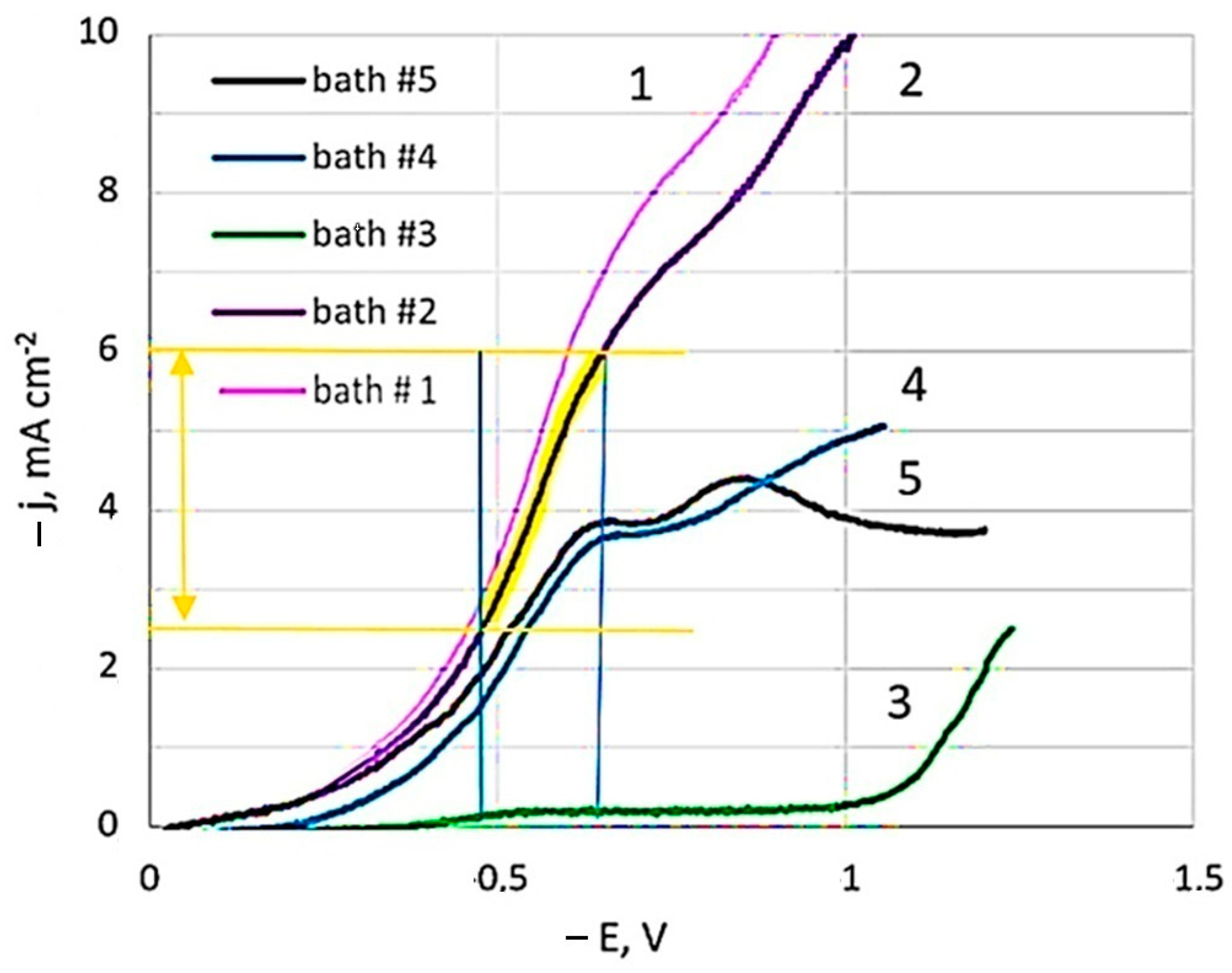
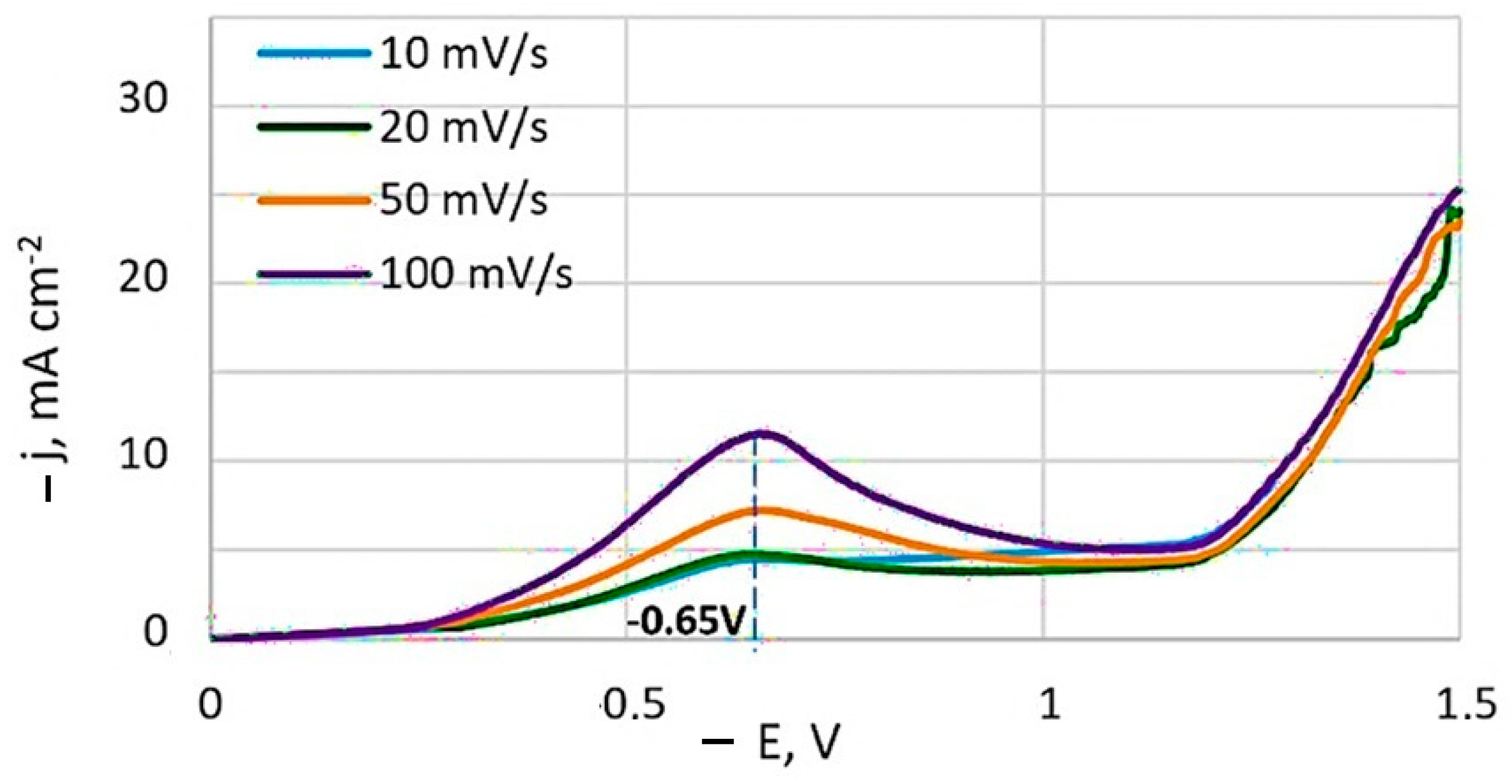

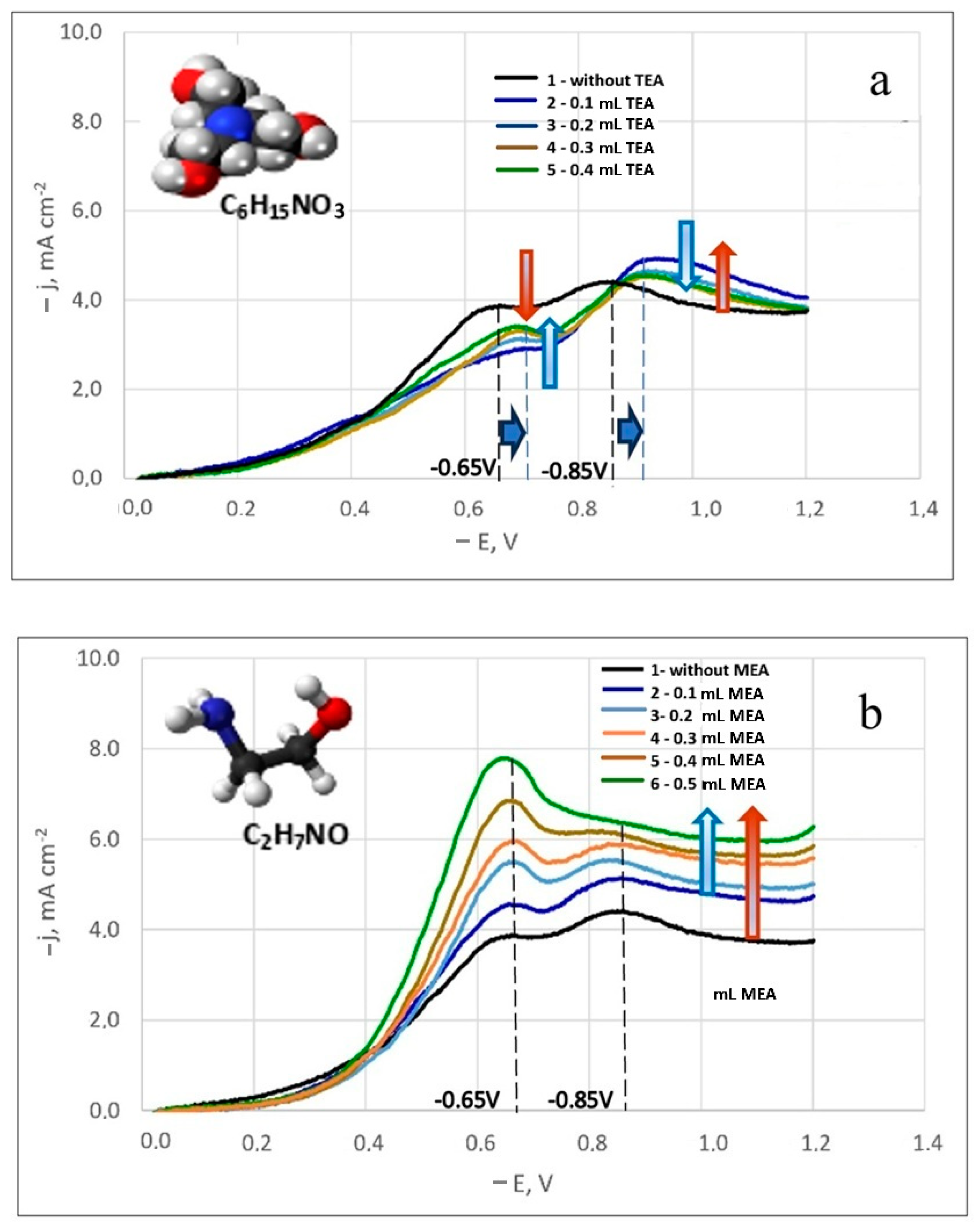
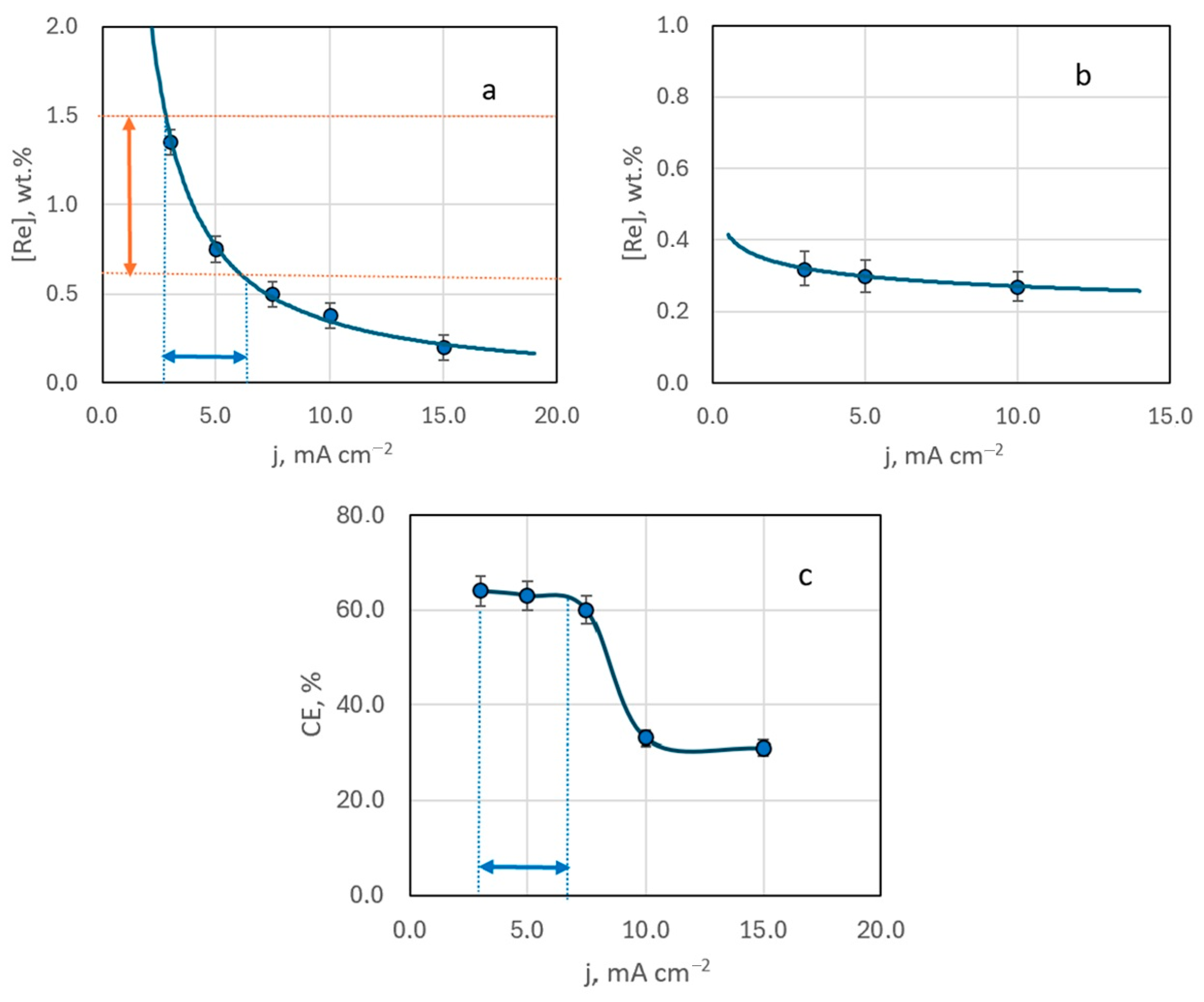

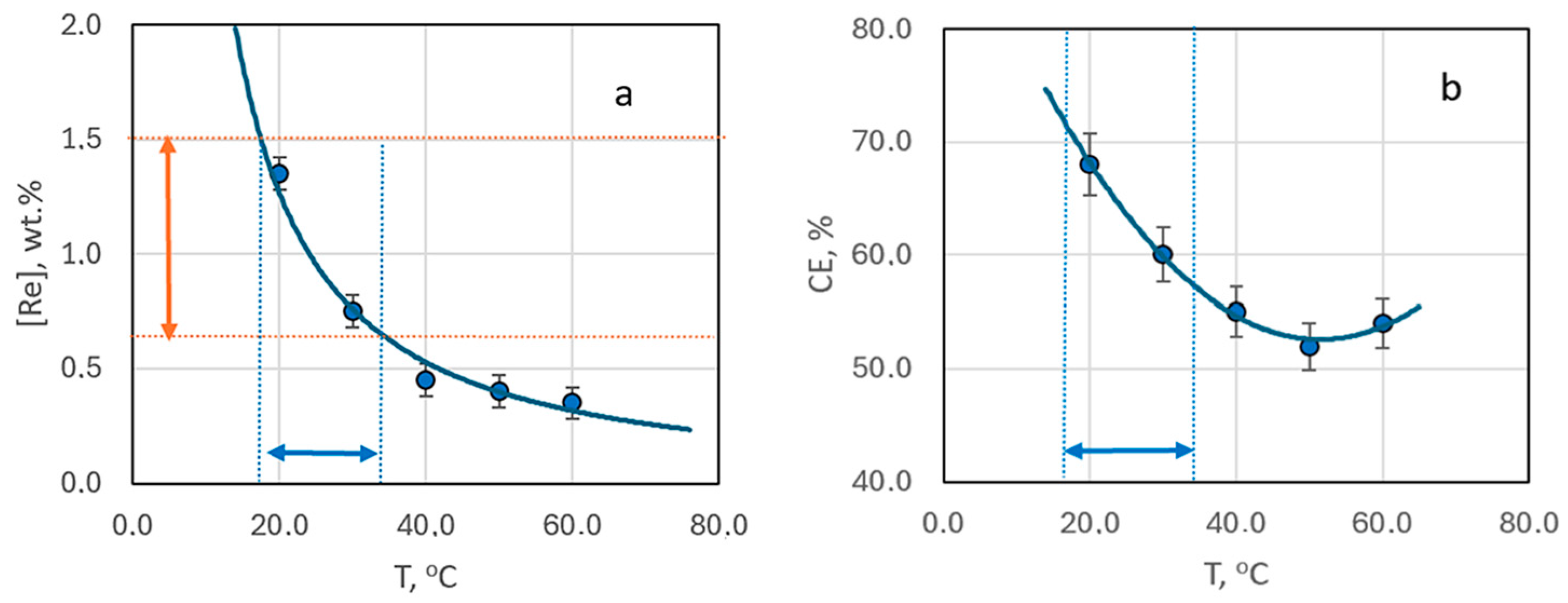
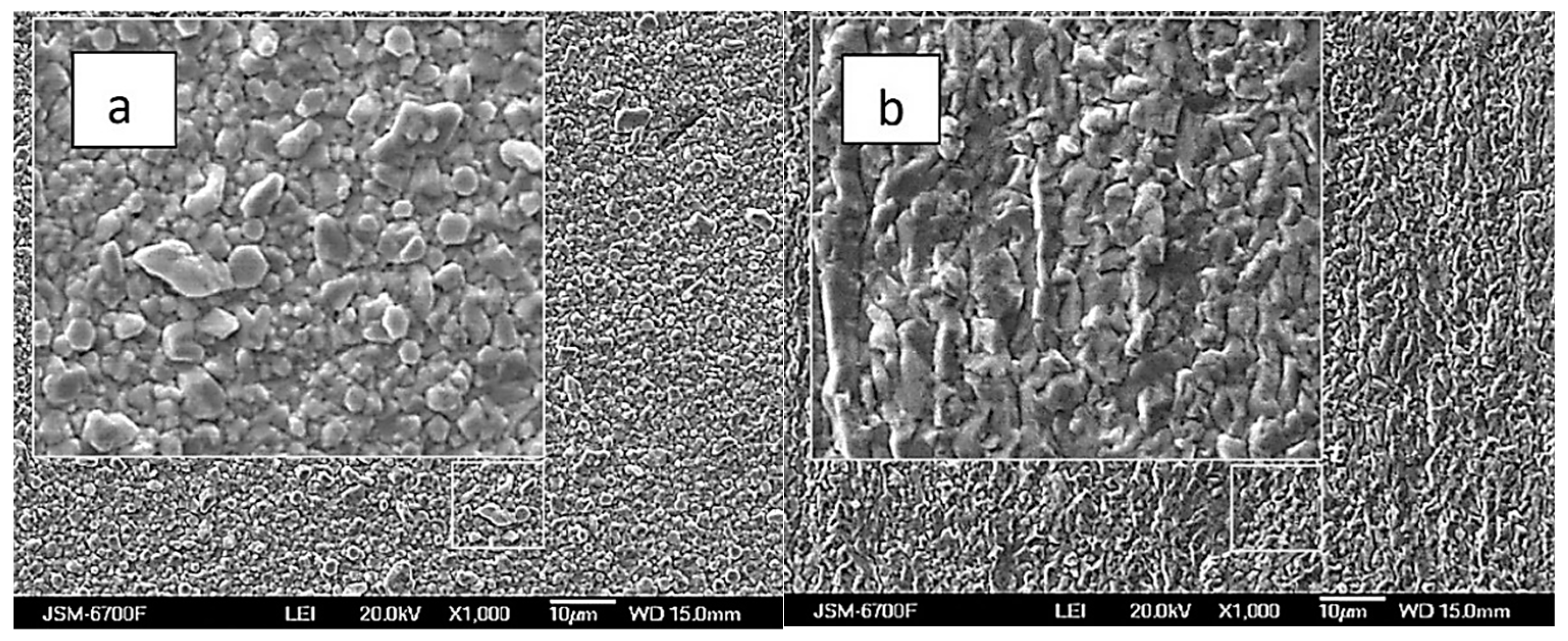
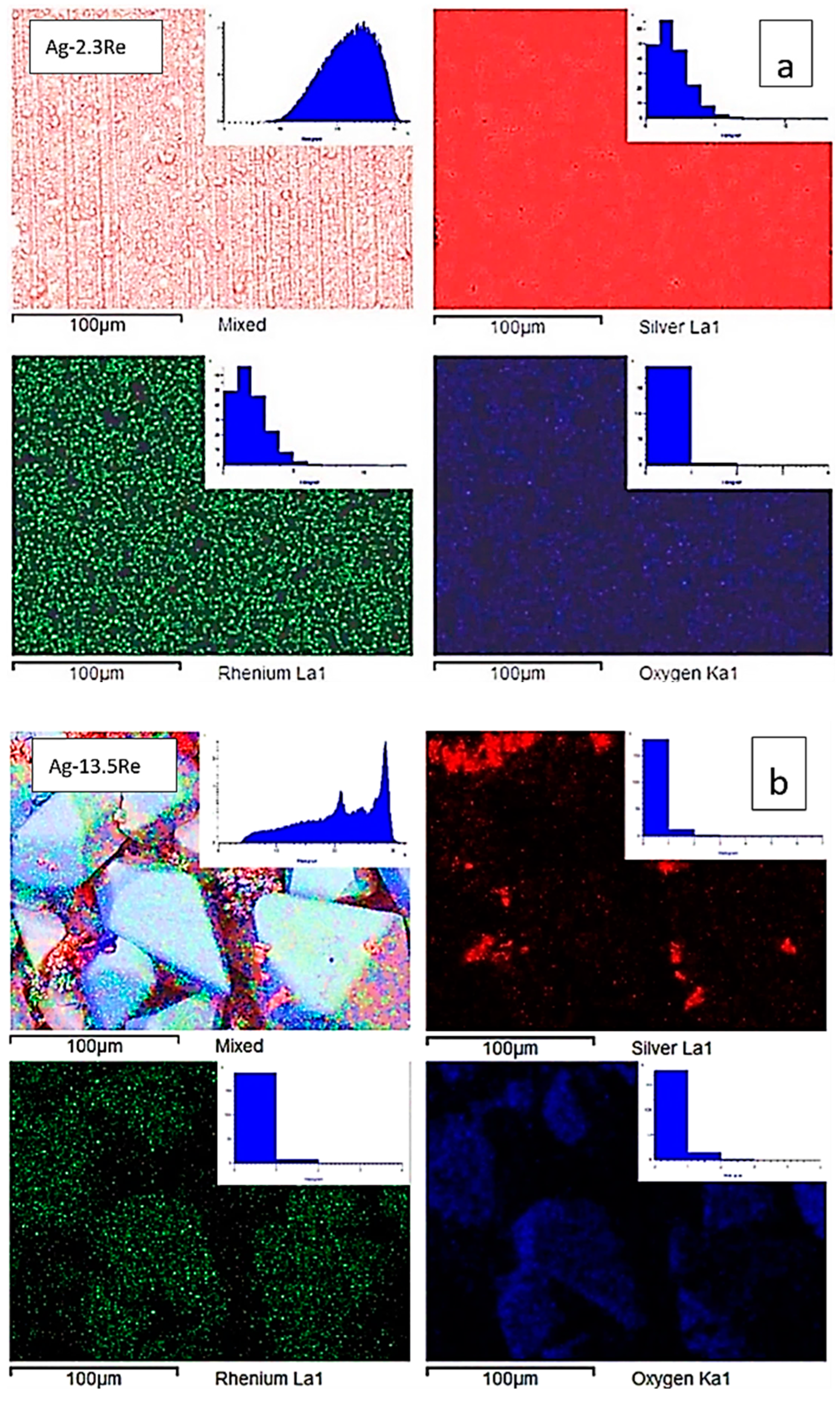
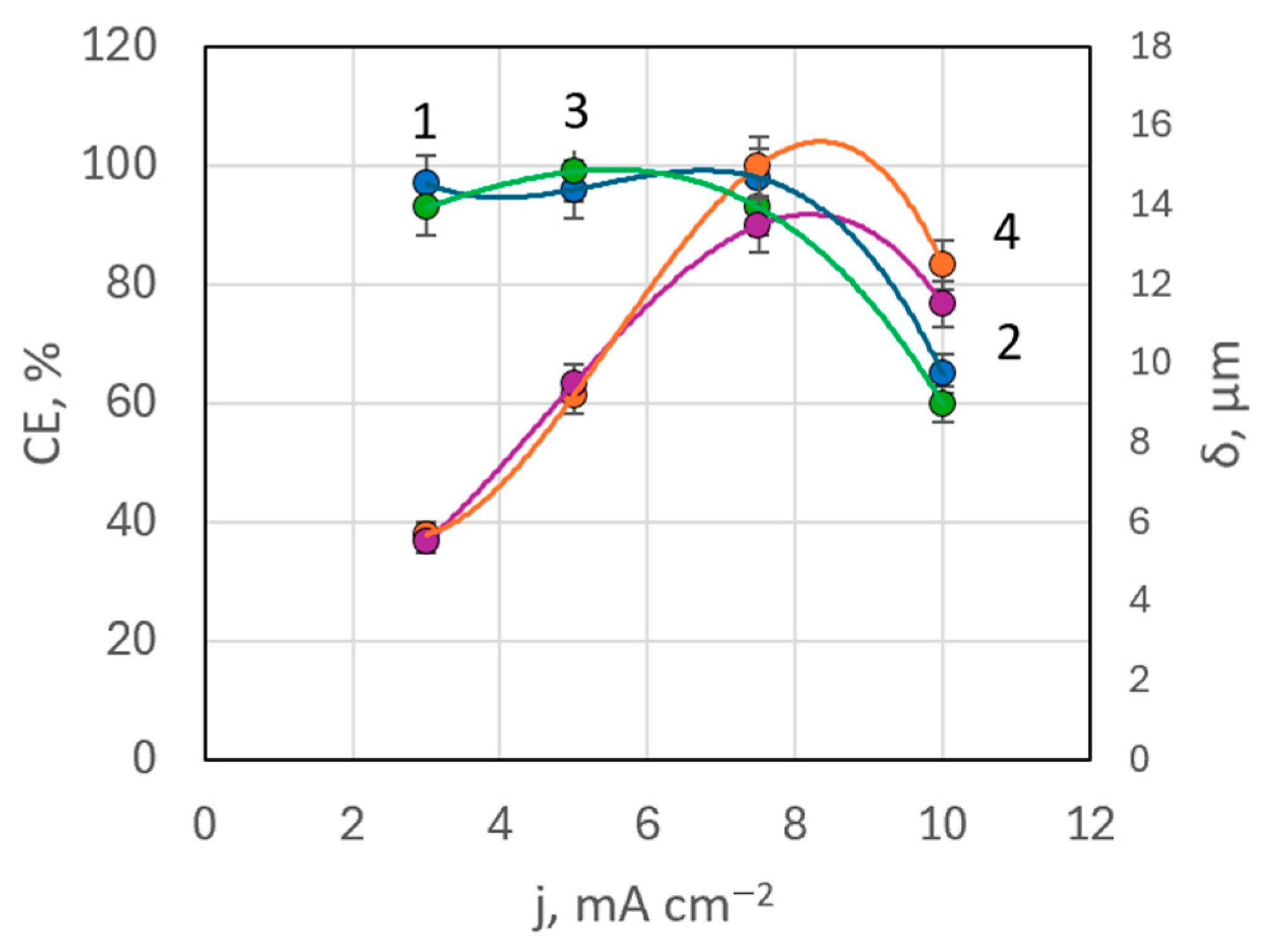
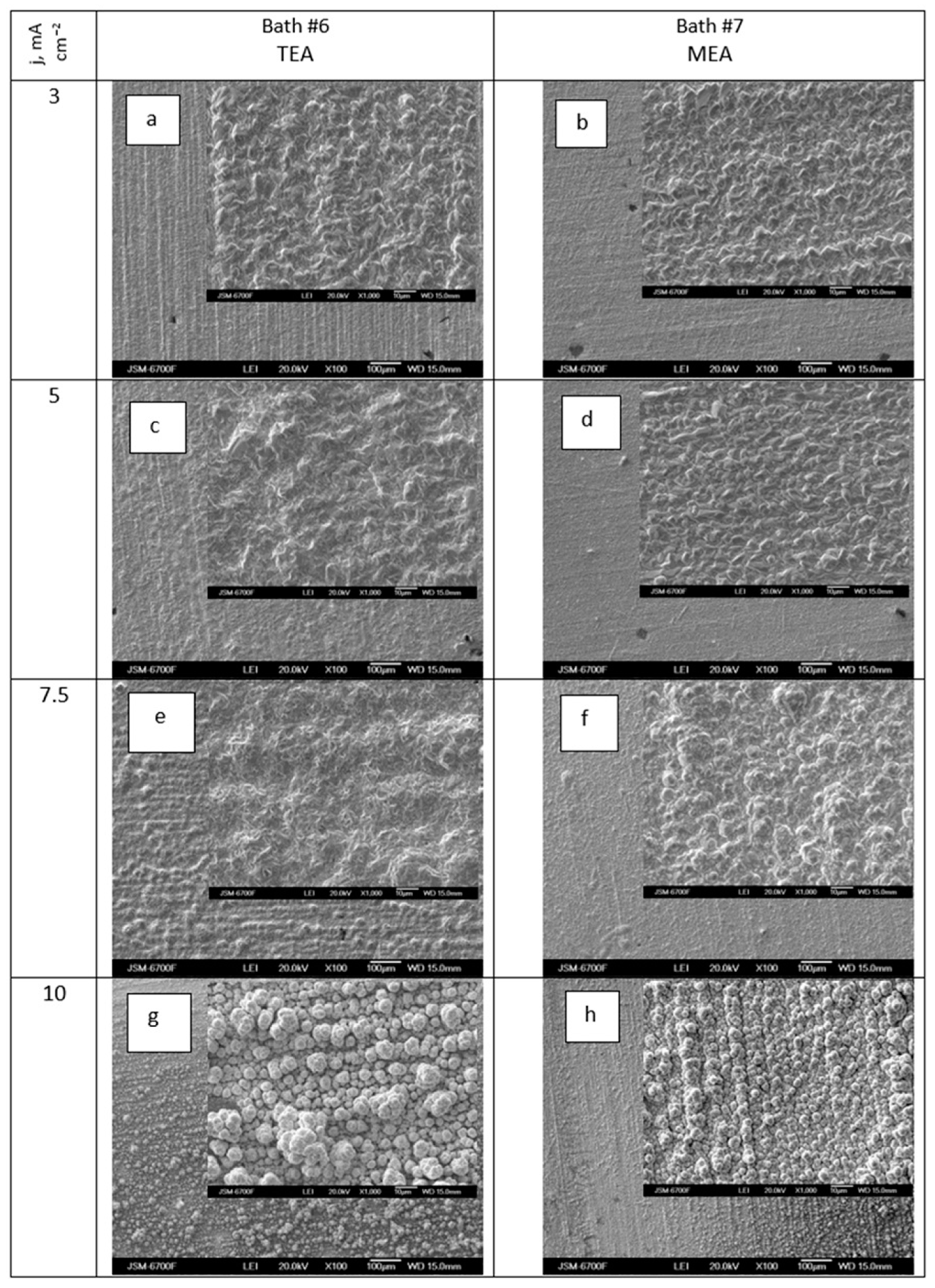
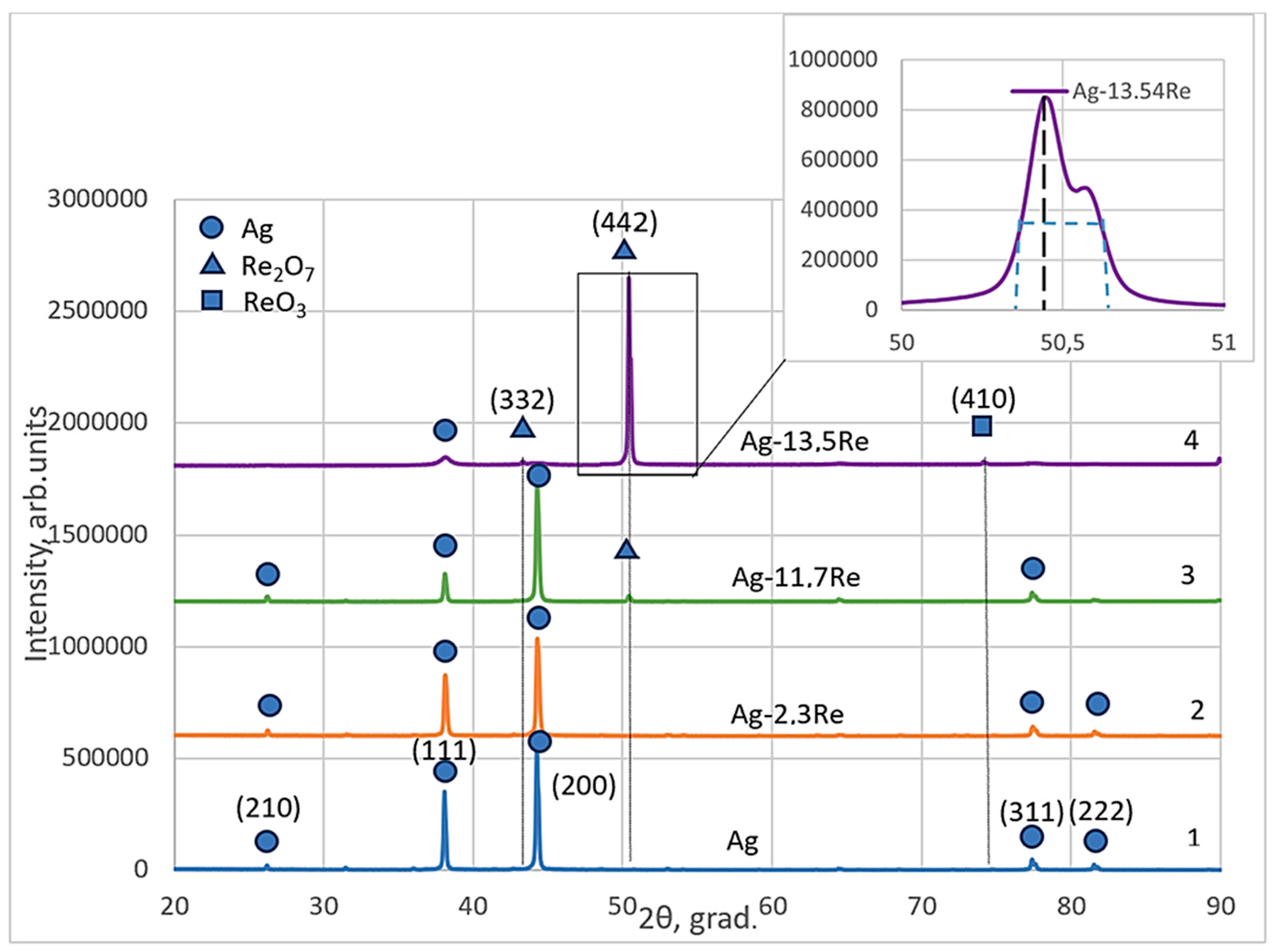

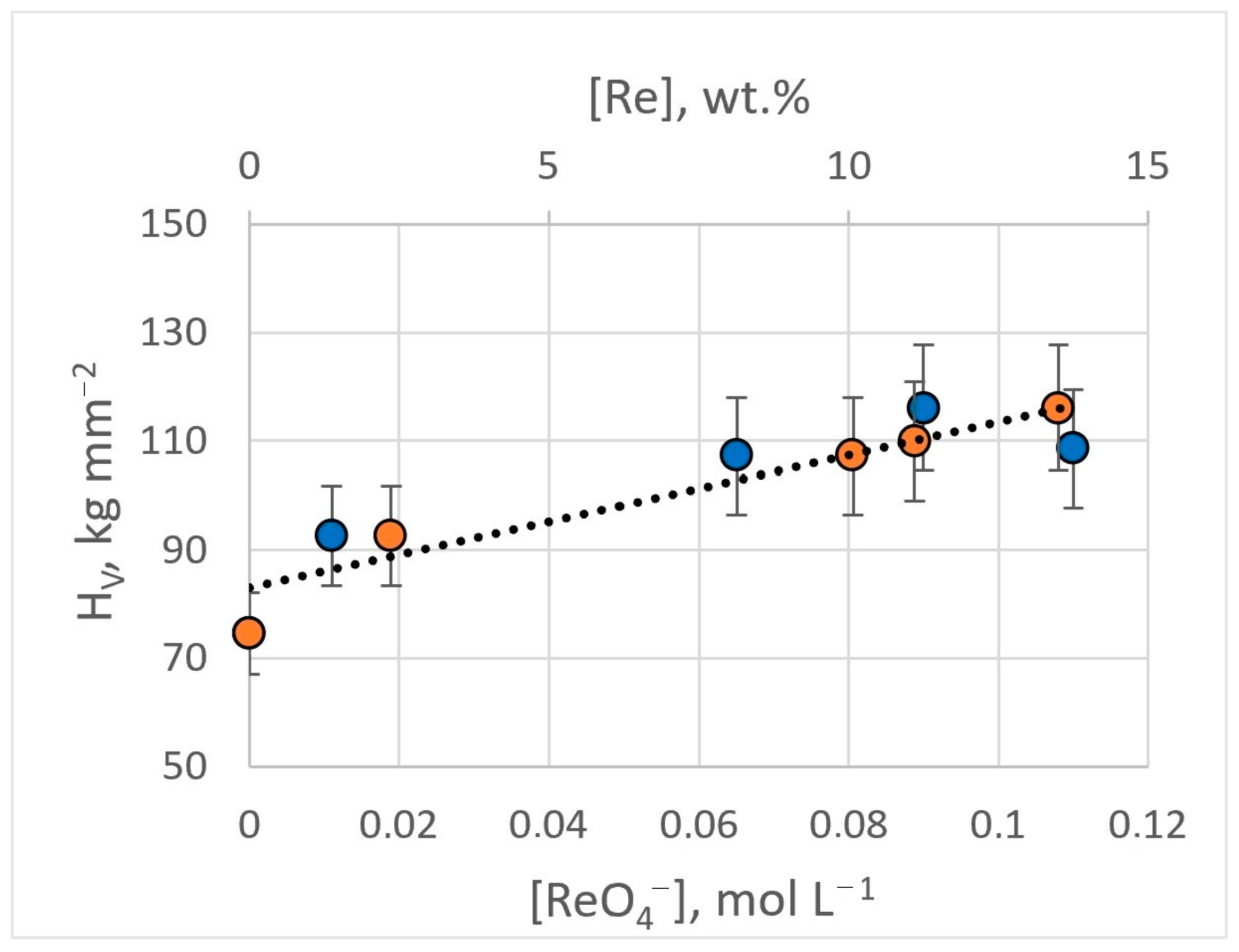
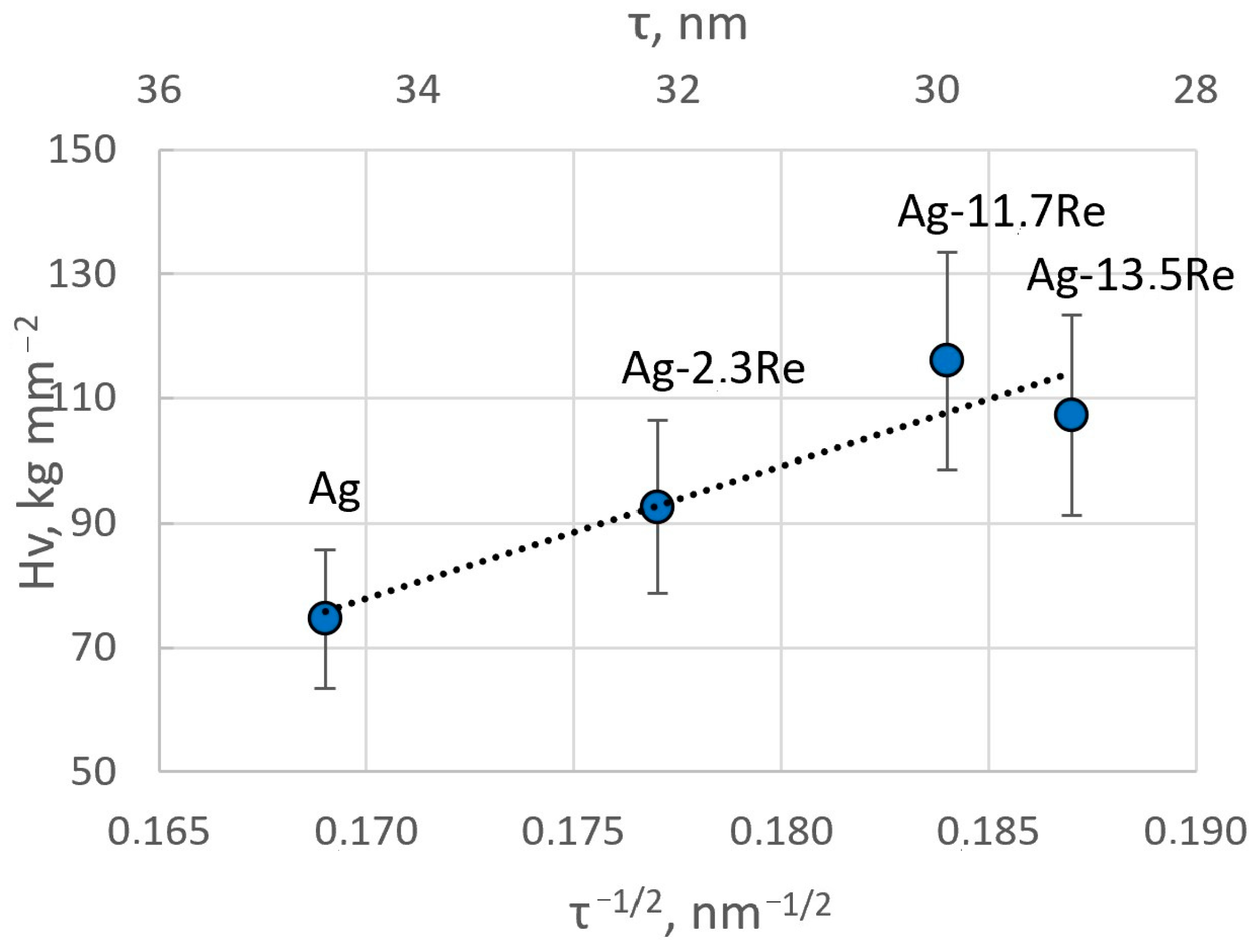
| Bath, (mol L−1) | #1 | #2 | #3 | #4 | #5 | #6 | #7 | #8 | #9 | #10 |
|---|---|---|---|---|---|---|---|---|---|---|
| NH4ReO4 | - | 0.011 | 0.022 | 0.0022 | - | - | - | - | - | - |
| KReO4 | - | - | - | - | 0.055 | 0.055 | 0.055 | 0.065 | 0.09 | 0.11 |
| KAg(CN)2 | 0.11 | 0.11 | 0.0044 | 0.022 | 0.11 | 0.11 | 0.11 | 0.044 | 0.009 | 0.011 |
| KH2PO4 | 0.05 | 0.05 | 0.002 | 0.01 | 0.05 | 0.05 | 0.05 | 0.025 | 0.014 | 0.005 |
| K2HPO4 | 0.3 | 0.3 | 0.01 | 0.06 | 0.3 | 0.3 | 0.3 | 0.15 | 0.085 | 0.03 |
| K2CO3 | 0.025 | 0.025 | 0.001 | 0.005 | 0.025 | 0.025 | 0.025 | 0.001 | 0.0055 | 0.0025 |
| H3BO3 | 0.2 | 0.2 | 0.007 | 0.04 | 0.2 | 0.2 | 0.2 | 0.1 | 0.05 | 0.02 |
| C2H7NO (MEA) | - | - | - | - | - | 0.033; 0.066; 0.099; 0.132; 0.160 | - | - | - | - |
| C6H15NO3 (TEA) | - | - | - | - | - | - | 0.015; 0.030; 0.045; 0.060 | - | - | - |
| [Ag+]:[ReO4−] ratio | - | 10:1 | 1:5 | 10:1 | 2:1 | 2:1 | 2:1 | 1:1.5 | 1:10 | 1:10 |
| pH (at 20 °C) | 7.00 | 7.65 | 7.80 | 7.60 | 7.21 | 8.78 (0.16 M MEA) | 8.15 (0.06 M TEA) | 8.18 | 8.42 | 8.49 |
| Bath | #1 | #2 | #3 | #4 | #5 | #6 | #7 |
|---|---|---|---|---|---|---|---|
| EAg, V (Ag/AgCl) | +0.200 | −0.022 | −0.122 | +0.024 | +0.007 | +0.170 | +0.110 |
| EPt, V (Ag/AgCl) | −0.0040 | −0.0145 | −0.030 | +0.004 | +0.004 | +0.150 | +0.0038 |
| Sample | Intensities Ihkl of Diffraction Peaks (in Arbitrary Units) | |||
|---|---|---|---|---|
| I111 | I200 | I311 | I222 | |
| Ag | 55 | 100 | 3 | 0.6 |
| Ag-2.3Re | 62 | 100 | 2 | 0.7 |
| Ag-11.7Re | 19.5 | 100 | 4 | 0.9 |
| Ag-13.5Re | 100 | ~0 | ~0 | ~0 |
| Bath #1 | Bath #2 [Ag+]:[ReO4−] = 10:1 | Bath #9 [Ag+]:[ReO4−] = 1:1.5 | Bath #10 [Ag+]:[ReO4−] = 1:10 | ||
|---|---|---|---|---|---|
| (111) | Θ, deg | 19.07 | 19.06 | 19.06 | - |
| dhkl, Å | 2.3567 | 2.3579 | 2.3579 | - | |
| a0, Å | 4.0770 | 4.0791 | 4.0791 | - | |
| (200) | Θ, deg | 22.16 | 22.15 | 22.14 | - |
| dhkl, Å | 2.0413 | 2.0422 | 2.0431 | - | |
| a0, Å | 4.0826 | 4.0844 | 4.0862 | - | |
| (311) | Θ, deg | 38.72 | 38.74 | 38.74 | - |
| dhkl, Å | 1.2309 | 1.2318 | 1.2318 | - | |
| a0, Å | 4.0824 | 4.0853 | 4.0853 | - | |
| (222) | Θ, deg | 40.62 | 40.62 | 40.62 | - |
| dhkl, Å | 1.1827 | 1.1827 | 1.1824 | - | |
| a0, Å | 4.0969 | 4.0969 | 4.0959 | - | |
| (442) | Θ, deg | - | - | - | 25.22 |
| dhkl, Å | - | - | - | 1.8071 | |
| a0, Å | - | - | - | 3.3202 | |
| (332) | Θ, deg | - | - | - | 21.66 |
| dhkl, Å | - | - | - | 2.0861 | |
| a0, Å | - | - | - | 2.2484 |
Disclaimer/Publisher’s Note: The statements, opinions and data contained in all publications are solely those of the individual author(s) and contributor(s) and not of MDPI and/or the editor(s). MDPI and/or the editor(s) disclaim responsibility for any injury to people or property resulting from any ideas, methods, instructions or products referred to in the content. |
© 2025 by the authors. Licensee MDPI, Basel, Switzerland. This article is an open access article distributed under the terms and conditions of the Creative Commons Attribution (CC BY) license (https://creativecommons.org/licenses/by/4.0/).
Share and Cite
Bersirova, O.; Kublanovsky, V.; Kochetova, S.; Bondar, O. Electrochemical Formation and Characterization of Functional Ag-Re Coatings. Materials 2025, 18, 1893. https://doi.org/10.3390/ma18091893
Bersirova O, Kublanovsky V, Kochetova S, Bondar O. Electrochemical Formation and Characterization of Functional Ag-Re Coatings. Materials. 2025; 18(9):1893. https://doi.org/10.3390/ma18091893
Chicago/Turabian StyleBersirova, Oksana, Valeriy Kublanovsky, Svetlana Kochetova, and Olena Bondar. 2025. "Electrochemical Formation and Characterization of Functional Ag-Re Coatings" Materials 18, no. 9: 1893. https://doi.org/10.3390/ma18091893
APA StyleBersirova, O., Kublanovsky, V., Kochetova, S., & Bondar, O. (2025). Electrochemical Formation and Characterization of Functional Ag-Re Coatings. Materials, 18(9), 1893. https://doi.org/10.3390/ma18091893






